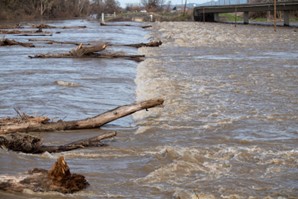WHAT TO KNOW: Governor Newsom signed an executive order to streamline levee repairs and debris removal to help local communities recover from flooding and prepare for the next wet season. This is the latest in a series of actions to protect communities and conserve water from record rain and snowfall.
SACRAMENTO – In anticipation of another possible wet season with record rain and snowfall, Governor Gavin Newsom today signed an executive order that will expedite critical work like levee repairs and debris removal to help protect and prepare communities.
A copy of the executive order can be found here.



WHY IT IS NEEDED: This year’s historic winter storms damaged levees and left debris in river channels that exacerbate the risk of flooding next winter – damaged levees provide less protection from high water flows, and debris and vegetation within river channels reduce capacity to move high water flows.
WHAT IT WILL DO: By acting now, the executive order allows affected communities to accelerate work to restore levee function and river channel capacity degraded by last winter’s storms and floods. More specifically, the executive order:
- Streamlines public agencies’ emergency levee repair and debris removal work to address this past winter’s storms and prepare for next winter;
- Applies to emergency levee repair and debris clearing impacted by this past winter’s storms, including: the San Joaquin River and tributaries, the Tulare Lake Basin and tributaries, the Salinas River and tributaries, the Pajaro River and tributaries, and other coastal streams between the Pajaro River and the Ventura River;
- Suspends certain laws, regulations, and criteria in existing orders – conditioned on agencies complying with specified environmental and resource protection requirements – for emergency levee repair and debris removal projects. Suspensions include:
- Lake and streambed alteration agreement laws and regulations implemented by the California Department of Fish and Wildlife;
- Limiting provisions in State Water Board water quality certifications that would otherwise limit circumstances under which a public agency could rely on emergency regional general permits issued by the U.S. Army Corps of Engineers;
- Waste discharge requirements laws and regulations implemented by the Water Boards for projects that do not require an Army Corps of Engineers emergency permit;
- The California Environmental Quality Act.
- Includes a number of common-sense conditions to protect the environment and natural resources, drawn from the existing regulatory expertise at the Department of Fish and Wildlife, Department of Water Resources, and the Water Boards.
HOW WE GOT HERE: This action builds on the series of measures Governor Newsom has taken to protect communities from flooding while replenishing California’s groundwater and storage.
- Proclaimed a state of emergency in January mobilizing state government ahead of the winter storms, proclaimed a state of emergency in 53 counties to support response and recovery efforts, and activated the National Guard to support disaster response and relief;
- At the Governor’s request, President Biden issued a Presidential Emergency Declaration and a Presidential Major Disaster Declaration to bolster state and local recovery efforts;
- Executive orders to expedite emergency flood preparation and response activities in the Tulare Lake Basin and San Joaquin River Basin, such as floodwater diversion, debris removal, and levee repairs;
- Visited the Tulare Lake Basin to see flooding impacts firsthand, meet with community leaders, and emphasize the state’s commitment to supporting the counties impacted by flooding.
- Announced $17.2 million to fortify the Corcoran Levee, protecting critical infrastructure, correctional and medical facilities, and more;
- Committed over $500 million in the 2023-24 state budget to support flood response and projects to protect communities from future floods;
- Executive orders in February and March to capture rain and floodwater for groundwater recharge, reservoir storage, and more.
Leveraging the more than $8.6 billion committed by Governor Newsom and the Legislature in the last two budget cycles to build water resilience, the state is continuing to take aggressive action to prepare for the impacts of climate-driven extremes in weather on the state’s water supplies.
###
